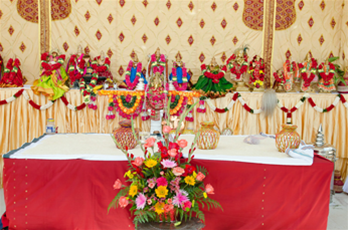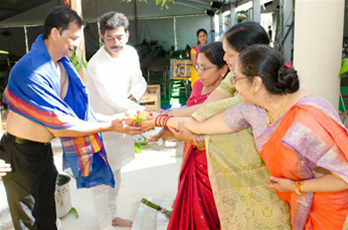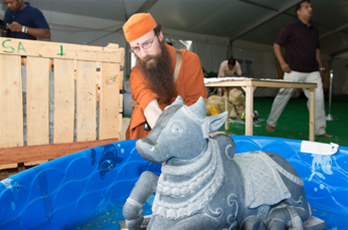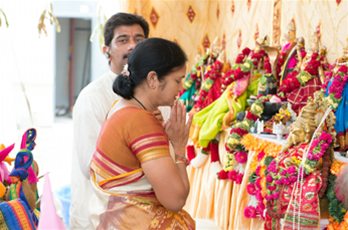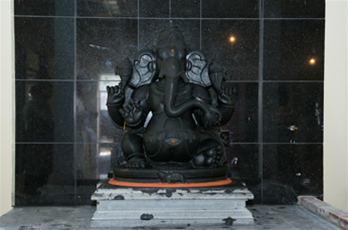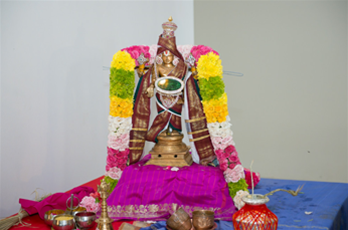

News & Updates 
Our Murthis and Devathas
Our Deities
- Sri Maha Ganapathi
- Sri Murugan (Subrahmanya Swamy)
- Sri Durga Devi (Ambaji)
- Sri Chandrashekhara (Shiva)
- Sri Venkateswara (Balaji)
- Sri Mahalakshmi
- Sri Ram Parivar
- Sri Radha Krishna
- Sri Garudalwar
- Sri Nandikeswara
- Navagraha
- Satyanarayana Swamy
LORD GANESHA
!! OM GANESHAYA NAMAHA !!
The Lord of Success
The son of Shiva and Parvati, Ganesha has an elephantine countenance with a curved trunk and big ears, and a huge pot-bellied body of a human being. He is the Lord of success and destroyer of evils and obstacles. He is also worshipped as the god of education, knowledge, wisdom and wealth. In fact, Ganesha is one of the five prime Hindu deities (Brahma, Vishnu, Shiva and Durga being the other four) whose idolatry is glorified as the panchayatana puja .
Significance of the Ganesha Form
Ganesha’s head symbolizes the Atman or the soul, which is the ultimate supreme reality of human existence, and his human body signifies Maya or the earthly existence of human beings. The elephant head denotes wisdom and its trunk represents Om , the sound symbol of cosmic reality. In his upper right hand Ganesha holds a goad, which helps him propel mankind forward on the eternal path and remove obstacles from the way. The noose in Ganesha’s left hand is a gentle implement to capture all difficulties.
The broken tusk that Ganesha holds like a pen in his lower right hand is a symbol of sacrifice, which he broke for writing the Mahabharata . The rosary in his other hand suggests that the pursuit of knowledge should be continuous. The laddoo (sweet) he holds in his trunk indicates that one must discover the sweetness of the Atman . His fan-like ears convey that he is all ears to our petition. The snake that runs round his waist represents energy in all forms. And he is humble enough to ride the lowest of creatures, a mouse.
Look upon every man, woman, and everyone as God. You cannot help anyone, you only serve; serve the children of the Lord, serve the Lord Himself, if you have the privilege. If the Lord grants that you can help any one of his children, blessed are you. -Swami Paramananda
LORD VENKATESWARA
!! OM NAMO VENKATESAYA NAMAHA !!
The original temple of Lord Venkateswara as all of us know has been on Tirumala (Tiru=sacred, Mala=Hill) for about 12 centuries since Pallava kings established it. The temple is sacred to us all because Lord Venkateswara (Vem= links with sins, Kata=cut, Eeswara=Lord) is one deity who would separate us the devotees from all our sins. As legend has it, Lord Vishnu came to hide in an ant hill on this hill to escape from the wrath of his concert Maha Lakshmi. A cowherd saw his cows providing milk to the Lord and reported to the king who erected the temple. Thus Sri Venkateswara is an Avatar of Lord Vishnu.
Lord Venkateswara of Tirumala hills is known by several other names. Balaji is one such name. According to the legends a boy named Bala was falsely accused of theft. The villagers chased and hit him on the head. The boy ran to the temple and took refuge there. When the villagers searched for the boy in the temple , the boy was not found anywhere but the idol of the Lord was bleeding. Hence name Balaji.
The idol is about eight feet tall and was very precisely sculpted which led some to believe that it was not made by human beings. The fist of His raised right hind hand is implanted with a gem-set chakra, and the corresponding left fist with the sankha suggesting that the temple follows the vaishnava tradition. However all Hindus worship this deity. The slightly outstretched front right hand, has its fingers pointing to His lotus feet, as the only recourse to His devotees to attain oneness with Him and enjoy eternal bliss. His front left hand is akimbo to assure His devotees of protection, and to show that the samsara sagara is only hip-deep if they seek His refuge. The Idol bears Lakshmi Devi on his right chest and Padmavathi Devi on his left chest. Thus he is also referred as Srinivasa (Sri=Lakshmi, Vasa=abode). The presence of Sridevi and Bhudevi metaphorically represent wealth and the source of wealth. There are other names as well. Edukondala vada, is the one on the seven hills, Govinda and others.
We are all happy that we would have a small replica of this highly praised temple. Annamacharya, Thyaga raja (a devotee of Rama), composed several kritis praising Lord Venkateswara. Ramanuja one of the three famous exponents of Hindu philosophy established the pooja traditions which are followed even today.
Literally millions of pilgrims from all over India as well as Hindus from other countries visit the temple at Tirumalai. Thousands of devotees donate incalculable wealth Thus he is the richest God in the world. This wealth is well utilized in establishing many educational institutions for the benefit of all.
Devotees give their hair as a sign of submission to the Lord. A legend associated with tonsure (hair donation) describes a devotee by name Nila cut her hair to replace the hair lost on the Lord’s head. Many of us may not be able to visit the sanctum sanctorum at Tirumalai but we can in our own humble way worship at this temple.
Temple Gallery
Reach Us
3000 Longvue Avenue Fort Worth, TX 76108.For any questions, Contact us @ Phone No: +1 817-292-4444
